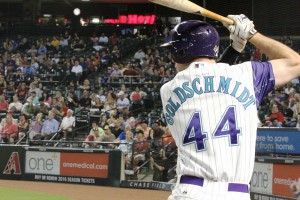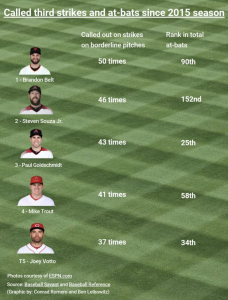- Slug: Sports-Diamondbacks Call Strikes, approximately 1,500 words.
- Photo available.
- Graphic available
By BEN LEIBOWITZ
Cronkite News
PHOENIX — With the advancement of sports analytics in Major League Baseball, virtually every statistic imaginable has a resource. Exit velocities and launch angles have dominated the discussion during a new wave of home run power, but even stats as rudimentary as balls and strikes have gained added meaning.
In the case of two Arizona Diamondbacks sluggers, they’ve been on the receiving end of some tough called third strikes in recent seasons.
Both Steven Souza Jr. and Paul Goldschmidt are within the top five of players who, dating back to the 2015 season, have been called out on strikes most often on pitches deemed outside the strike zone, according to data from Baseball Savant.
The full top five of players being rung up the most on those borderline non-strikes includes San Francisco Giants first baseman Brandon Belt (50 times), Souza (46), Goldschmidt (43), Los Angeles Angels two-time MVP Mike Trout (41) and Cincinnati Reds former MVP Joey Votto (tied with two others at 37).
When told he was in the top five of that niche statistic, Goldschmidt laughed and said, “There’s no way I’m commenting for this story.”
The veteran slugger, who has twice finished second in National League MVP voting, didn’t want to come across as critical of the league’s umpires.
“I just try to have good at-bats,” he said.
Four of the top five players who’ve been sent back to the dugout most frequently on such calls have been named All-Stars in their careers. The proverbial black sheep of the bunch, though no slouch in the batter’s box himself, is Goldschmidt’s teammate.
“It sounds like one guy doesn’t belong there, to me,” Souza said jokingly about being in the same company as a plethora of All-Stars.
“I’d like those pitches back, if you ask me,” he said of being called out on strikes 46 times since 2015 despite showing good plate vision.
Souza added later that he was “shocked” by the statistic and by being among those on the list, but he also said that MLB umpires have difficult responsibilities out on the diamond.
“Look, it’s a hard job to be an umpire at the end of the day,” Souza said. “I mean, that’s frustrating obviously at the end that you’re near the top in that category, but you obviously want to stay disciplined as a hitter.”
Interestingly, plate discipline is a likely variable that puts those accomplished hitters at the top of such a list.
When asked why he believes these players in particular are atop their peers, retired MLB umpire John Hirschbeck — who served in the big leagues for 34 years after seven years in the minors — credited the players.
“Oh my gosh, umm, well, maybe because they have a better eye for the strike zone,” Hirschbeck said. “I mean, the world of baseball now is nothing but statistics. And they don’t lie, so my only thing would be that those guys have a real good eye for the strike zone.”
Because the players getting rung up on those borderline calls are all accomplished hitters, Hirschbeck reasoned that they know when pitches are just off the plate and utilize that elite discipline accordingly, much like baseball Hall of Famers who came before them.
“If I go back in my career, I mean, guys like … Rod Carew, Wade Boggs, George Brett, I can name guys that … they just knew if the pitch was an inch off the plate,” Hirschbeck said.
Unlike the NBA, where there’s a generally accepted narrative that star players sometimes can get preferential treatment from referees, the opposite seems to be true in baseball. Hirschbeck said that the most important factor in becoming a respected umpire is consistency.
“It was the same for everybody. Again, whether it’s the World Series or spring training, you just try to be the same day in and day out so that (players) know that they’re going to be treated fairly,” he said.
Hirschbeck also mentioned Hall of Fame pitcher Greg Maddux and the perception that he received a larger strike zone compared to his peers.
“If anyone could pitch on the corners like Greg Maddux could, he’d get the same thing. You don’t have to earn it. It’s either it is or it isn’t. I don’t make some kid, because he’s a rookie, come out and earn it,” he said.
But the “it is or it isn’t” rule of thumb is not exactly an absolute in the world of called strikes and balls, at least according to those who study the subject.
Harry Pavlidis, a member of the Society for American Baseball Research who runs Baseball Prospectus’ stats department, refers to called strikes as an “artificial binary.” In layman terms, borderline pitches would be called strikes around 50 percent of the time anyway, whereas pitches right down the middle are strikes 99 percent of the time and pitches in the dirt are never called for strikes.
As such, it’s not quite fair to say pitches outside Baseball Savant’s designated strike zone should automatically be viewed as balls when the percentage of calls is much more nuanced. Still, Pavlidis echoed Hirschbeck in crediting the hitters for their eye at the plate.
“They have that quality of eye and judgment that makes them take more borderline pitches,” Pavlidis said. “And if you add it up, they’ll get more calls against them.”
“The underlying skill set that makes them quality hitters is the same skill set that makes them probably take a pitch that’s borderline that will be called a strike. It’s just a side effect of it,” he said.
When these players are letting borderline pitches go, they’re taking a calculated risk. It could be called for a strike, but the odds of them doing damage on pitches they view as outside the zone sometimes isn’t worth that risk.
Pavlidis also said that the added emphasis on catcher pitch framing could be a factor. In today’s MLB, if catchers can’t be at least average in regard to pitch framing, they won’t last long at the position.
Another obvious variable that could tie in to the stat that’s been handcuffing guys like Goldschmidt and Souza is sheer sample size. Logically speaking, if a player has accumulated more at-bats, he’d be put in more situations to be called out on strikes.
In looking at those figures, however, there doesn’t seem to be a clear link between the two.
Since the 2015 season (the sample size in question), Goldschmidt ranks No. 25 in the league in at-bats — leading the way among the top five players getting rung up the most.
Belt, however, ranks No. 90 in total at-bats during that span despite leading his peers in taking called third strikes on pitches out of the zone.
Out of the top five, though, Souza has perhaps the biggest gripe. There are 151 MLB players who’ve logged more at-bats than him since 2015, yet he’s been called out on pitches deemed outside the zone 46 times (second-most of his peers).
Souza said he often talks to the umpires following called third strikes to get a sense of where the pitch was according to their zone. If there is a silver lining, it’s that Souza, as Hirschbeck alluded to, is displaying good plate discipline.
“I think it’s kind of cool to be reassured,” Souza said. “It’s nice to know a lot of the times you still have a pretty good idea for the zone.”
For more stories from Cronkite News, visit cronkitenews.azpbs.org.

